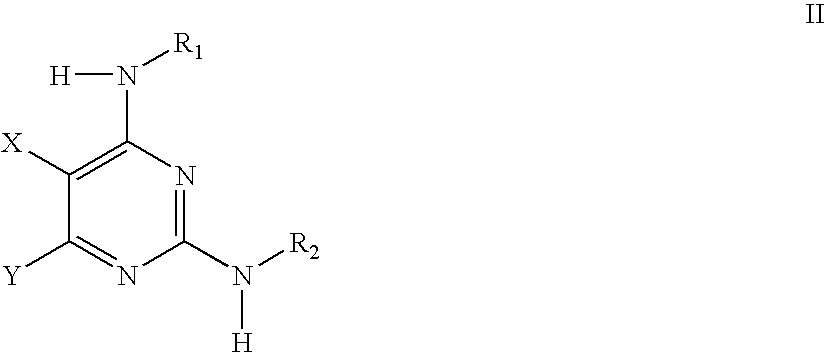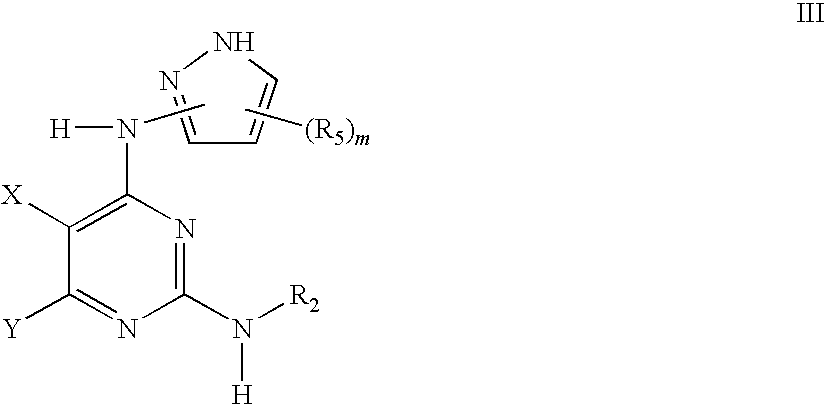Methods of Using IGFIR and ABL Kinase Modulators
- Summary
- Abstract
- Description
- Claims
- Application Information
AI Technical Summary
Benefits of technology
Problems solved by technology
Method used
Image
Examples
example 1
N4-(5-Isopropyl-1H-pyrazol-3-yl)-N6-[2-(4-methylpiperazin-1-yl)ethyl]-N2-(3-phenylisoxazol-5-ylmethyl)-pyrimidine-2,4,6-triamine
[0291]
[0292]4-Methyl-3-oxopentanenitrile. A solution of acetonitrile (25.2 mL, 480 mmol) in THF (300 mL) was cooled to −78° C. in a dry ice / acetone bath, and n-butyllithium (255 mL, 1.6 M in hexanes, 408 mmol) was added dropwise. The solution was stirred at −78° C. for 2 h and isobutyril chloride (25.2 mL, 240 mmol) was added dropwise. The reaction was maintained at −78° C. for 1 h, allowed to warm to room temperature for 2 h and then stored in a refrigerator overnight. The reaction was quenched with 3 N HCl, extracted with ether, washed with water and brine and dried over sodium sulfate. The solvent was removed on a rotary evaporator to give the desired product (25 g, 94%) as a light brown oil that was used without further purification.
[0293]5-Isopropyl-1H-pyrazol-3-ylamine. A solution of 4-methyl-3-oxopentanenitrile (25 g, 225 mmol) and hydrazine (6.75 mL...
example 2
N4-(5-Cyclopropyl-1H-pyrazol-3-yl)-6-methyl-N2-(3-phenylisoxazol-5-ylmethyl)-pyrimidine-2,4,6-triamine
[0299]
[0300]2-Chloro-6-methylpyrimidin-4-yl-(5-cyclopropyl-1H-pyrazol-3-yl)-amine. A mixture of 2,4-dichloro-6-methylpyrimidine (30.0 g, 184 mmol), 5-cyclopropyl-1H-pyrazol-3-ylamine (22.6 g, 184 mmol) and diisopropylethylamine (46 mL, 278 mmol) in 1-butanol (50 mL) was heated to 60° C. for 65 h. The reaction was cooled to room temperature and diluted with ethyl acetate. The mixture was washed with 2 N sodium hydroxide, water and brine, then dried over sodium sulfate and concentrated on a rotary evaporator. The residue was treated with a small amount of acetonitrile, sonicated and then triturated with ether until a solid was formed. The solid was collected by filtration to give the desired product (23.0 g, 50%) as a yellow solid.
[0301]N4-(5-Cyclopropyl-1H-pyrazol-3-yl)-6-methyl-N2-(3-phenylisoxazol-5-ylmethyl)-pyrimidine-2,4,6-triamine. A mixture of 2-chloro-6-methylpyrimidin-4-yl-(...
example 3
5-Bromo-N4-(5-cyclopropyl-1H-pyrazol-3-yl)-N2-(4-dimethylaminobenzyl)-pyrimidine-2,4-diamine
[0303]
[0304]5-Bromo-2-chloropyrimidin-4-yl-(5-cyclopropyl-1H-pyrazol-3-yl)-amine. A mixture of 5-bromo-2,4-dichloropyrimidine (15.4 g, 67.6 mmol), 5-cyclopropyl-1H-pyrazol-3-ylamine (10.0 g, 81.3 mmol) and diisopropylethylamine (17 μL, 102 mmol) in 1-butanol (150 mL) was heated to 80° C. for 1 h. The solid that formed was collected by filtration and washed with acetonitrile to give the desired product (15.8 g, 75%) as a white solid.
[0305]5-Bromo-N4-(5-cyclopropyl-1H-pyrazol-3-yl)-N2-(4-dimethylaminobenzyl)-pyrimidine-2,4-diamine. A mixture of 5-bromo-2-chloropyrimidin-4-yl-(5-cyclopropyl-1H-pyrazol-3-yl)-amine (313 mg, 1.00 mmol) and 4-dimethylaminobenzylamine (225 mg, 1.5 mmol) in 1-butanol (20 mL) was heated to 170° C. in a 50 mL sealed tube for 3 h. The mixture was cooled and diluted with ethyl acetate. The organic layer was washed with 2 N sodium hydroxide, water and brine and dried over ...
PUM
| Property | Measurement | Unit |
|---|---|---|
| Fraction | aaaaa | aaaaa |
| Chemotherapeutic properties | aaaaa | aaaaa |
Abstract
Description
Claims
Application Information
 Login to View More
Login to View More - R&D
- Intellectual Property
- Life Sciences
- Materials
- Tech Scout
- Unparalleled Data Quality
- Higher Quality Content
- 60% Fewer Hallucinations
Browse by: Latest US Patents, China's latest patents, Technical Efficacy Thesaurus, Application Domain, Technology Topic, Popular Technical Reports.
© 2025 PatSnap. All rights reserved.Legal|Privacy policy|Modern Slavery Act Transparency Statement|Sitemap|About US| Contact US: help@patsnap.com



